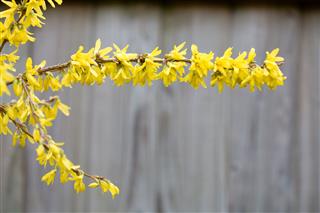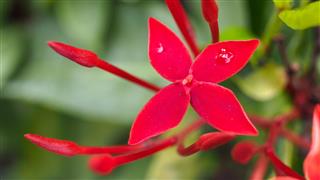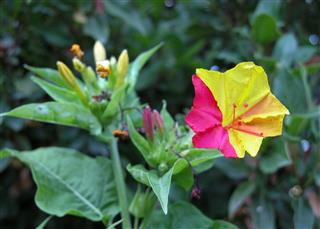
Jasmine plant offers a wide choice to garden enthusiasts, from vines to shrubs, and from pink blooms to bright yellow ones. Add a touch of bliss by having these beauties bloom in your garden.
Did you know…
…there exists a true jasmine and false jasmine, which are confused with each other due to the fragrance. True jasmine is a climber, and is non-poisonous, however, false jasmine is quite poisonous.
Varieties of jasmine are countless, with over 200 natural and cultivated species. A genus of shrubs and vines, jasmine belongs to the Oleaceae (olive) family. Jasmine is native to the old world. However, its fragrance and use in tea and aroma essential oils, combined with the fact the white, cream or yellow cluster of flowers that bloom on this plant, has made it a favorite houseplant. It is also one of the most commercially profitable plants to grow. A jasmine flower plant can either be a shrub or a climber with woody vines, depending upon its species. Mostly evergreen, the foliage is glossy, bright green, about 2 – 3 inches long, arranged oppositely, and collectively in a pinnate pattern with five to nine leaflets. The flowers are either five or more than five-lobed and extremely fragrant.
Varieties of Jasmine Plants
As said earlier, there are countless varieties, and some of these varieties have been introduced from the wild as well. This fact gives you a choice to grow some plants indoors, as ground cover, or as climbers that can be trained on walls, screens, overhead trellis, or just dropped down from hanging baskets. I have listed some of the popular plant varieties that one can easily purchase from local nurseries.

Forest Jasmine: Botanically known as Jasminum abyssinicum, this species is a woody climber with dark glossy green foliage, and five or six lobed flowers are borne at the ends twigs in axils of leaves, they are a bright white with pink fringes.
Primrose Jasmine: This tall, slender, evergreen shrub is also known as Japanese jasmine, and botanically Jasminum mesnyi. Its slender stems have a trailing tendency that need support as it grows. Being a vigorous grower, they grow really fast and respond well to regular pruning. Primrose jasmine plant bear small yellow-green unscented flowers.
Common Jasmine: Native to Iran, Jasmine officinale, as this jasmine is scientifically known as, is the most recognizable and common of all Jasmine varieties. The flowers it bears are white, heavily scented, and a source of oil used in perfumery and cosmetics. This variety grows mostly as woody shrubs, but can be trained to be a climber as well.
Spanish Jasmine: Like the common jasmine, Spanish jasmine is highly valued for its scent. The concentrates extracted from this jasmine, are widely used in Ayurveda herbal medicines and perfumes. It is botanically known as Jasminum grandiflorum, and is a deciduous shrub/climber that bears sweet, scented flowers.
Gold Coast Jasmine: An evergreen climber which can be trained as a rambling shrub, Gold Coast jasmine is botanically known as Jasminium dichotomum. The white flowers with light pink tinges bloom all yearlong, are fragrant, and open at night.

Pink Jasmine: An evergreen twining climber from China, pink jasmine is botanically known as Jasminum polyanthum. It produces a large profusion of fragrant five-petaled, star-shaped white or light pink with red tinge flowers, that appear as faint pink while in a bud form on vines that are semi-deciduous to evergreen. A vigorous grower that grows up to 6 meters in height annually, and so would require regular pruning to keep in shape.

Winter Jasmine: Awarded the Britain’s Royal Horticultural Society’s Award of Garden Merit (AGM), with a winter jasmine in your garden you sure have a winner in your hands. Native to China, winter jasmine is scientifically known as Jasminum nudiflorum. It bears tiny, bright yellow blooms, nestled between its evergreen bright foliage. Unlike many other jasmine vine varieties, it does not twine, so needs to be constantly pruned.
Star Jasmine: Star jasmine, Confederate jasmine or Trachelospermum Jasminoides as they are scientifically known, are very small in height (no more than 20 inches), combined with dense foliage, which makes it excellent for ground cover. It bears scented white flowers from late winter to early summer.

Arabian Jasmine: An evergreen vine or shrub that can grow anywhere between 1 – 3 m tall, this species bears flowers that open at night and close in the morning. The white flowers borne in clusters of 5 – 20, are strongly scented. Botanically it is known as Jasminum sambac.
Italian Jasmine: A very rambling evergreen shrub or vine that can quickly cover up screens and walls, this variety bears clusters of fragrant, bright yellow flowers all summer. Botanically Italian jasmine is known as Jasminum humile.

Other Varieties
Besides the above famous and easily available varieties there are also a few more, that one will have to scout through plant nurseries.
| Jasminum floridum (Showy Jasmine) | Jasminum parkeri (Dwarf Jasmine) |
| Jasminum auriculatum | Gelsemium sempervirens (Carolina Jasmine) |
| Jasminum azoricum (Lemon-scented Jasmine) | Jasminum laurifolium Roxb. |
| Jasminum leratii Schltr. | Jasminum multipartitum (Starry Wild Jasmine) |
| Jasminum volubile (Stiff Jasmine) | Jasminum dasyphyllum |
| Jasminum lanceolarium Roxb. | Jasminum flavovirens |
| Jasminum multiflorum (Indian Jasmine) | Jasminum pauciflorum Benth. |
| Jasminum nervosum Loureiro | Jasminum niloticum |
| Jasminum nardydorum | Jasminum newtonii |
| Jasminum aemulum | Jasminum albicalyx Kobuski |
| Jasminum angustifolium | Jasminum angolense |
| Jasminum arborescens | Jasminum angulare (Wild Jasmine) |
| Jasminum fluminense | Jasminum fruticans |
| Jasminum humile (Italian Yellow Jasmine) | Jasminum kajewskii |
| Jasminum kerstingii | Jasminum longipetalum |
| Jasminum meyeri-johannis | Jasminum microcalyx |
| Jasminum narcissiodorum | Jasminum lasiosepalum |
| Jasminum molle | Jasminum newtonii |
| Jasminum odoratissimum (Yellow Jasmine) | Jasminum pentaneurum |
| Jasminum pubigerum | Jasminum rufohirtum |
| Jasminum wengeri | Jasminum subhumile |
| Jasminum stenolobum | Jasminum subglandulosum |
| Jasminum tortuosum | Jasminum yuanjiangense |
I am sure after going through this list of jasmine plant varieties, which includes the famous ones, it will get confusing while choosing. But then, no one said you can’t have more than one jasmine blooming in your landscape!










